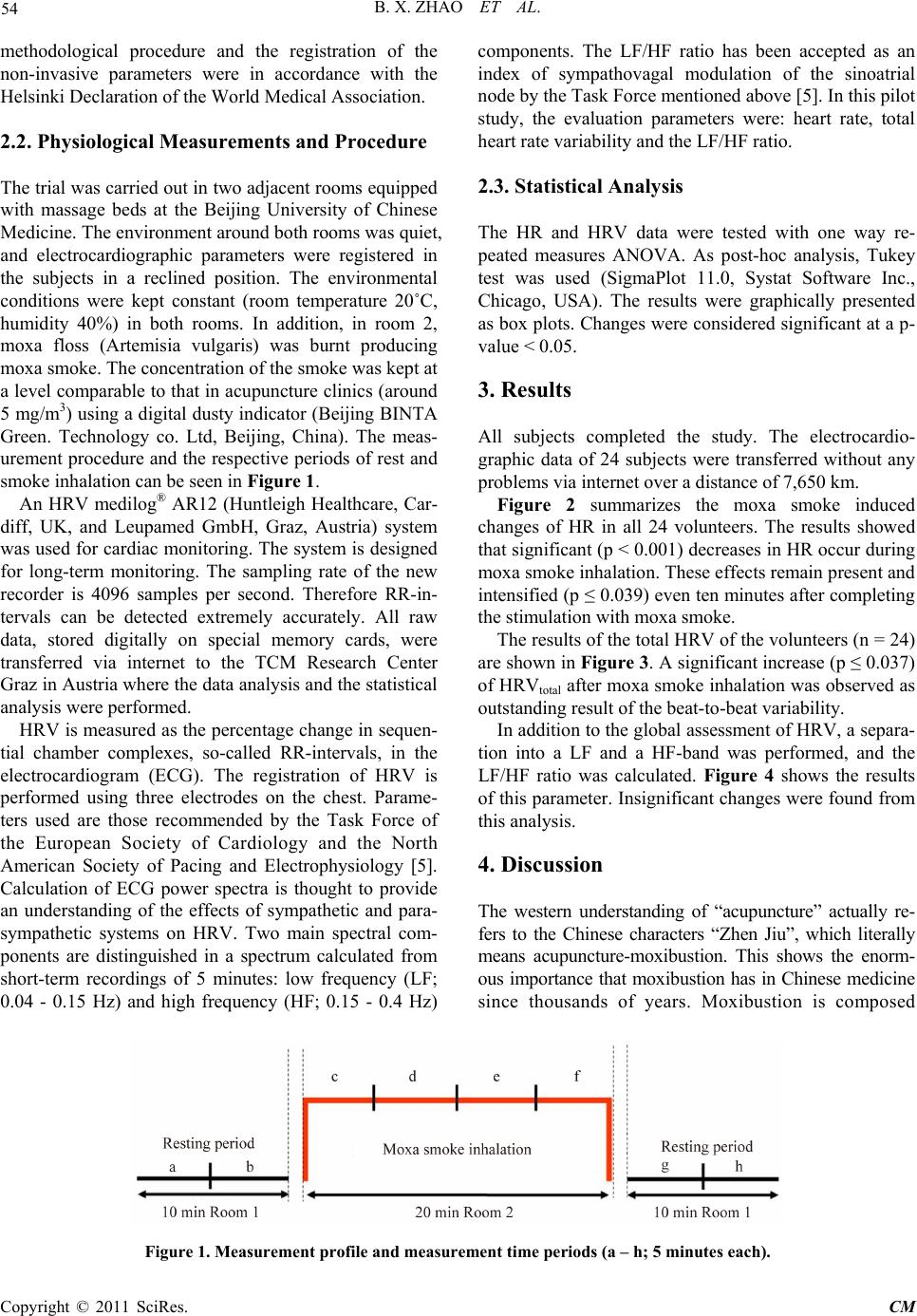
B. X. ZHAO ET AL.
Copyright © 2011 SciRes. CM
methodological procedure and the registration of the
non-invasive parameters were in accordance with the
Helsinki Declaration of the World Medical Association.
2.2. Physiological Measurements and Procedure
The trial was carried out in two adjacent rooms equipped
with massage beds at the Beijing University of Chinese
Medicine. The environment around both rooms was quiet,
and electrocardiographic parameters were registered in
the subjects in a reclined position. The environmental
conditions were kept constant (room temperature 20˚C,
humidity 40%) in both rooms. In addition, in room 2,
moxa floss (Artemisia vulgaris) was burnt producing
moxa smoke. The concentration of the smoke was kept at
a level comparable to that in acupuncture clinics (around
5 mg/m3) using a digital dusty indicator ( Beijing BINTA
Green. Technology co. Ltd, Beijing, China). The meas-
urement procedure and the respective per iods of rest and
smoke inhalation can be seen in Figure 1.
An HRV medilog® AR12 (Huntleigh Healthcare, Car-
diff, UK, and Leupamed GmbH, Graz, Austria) system
was used for cardiac monitoring. The system is designed
for long-term monitoring. The sampling rate of the new
recorder is 4096 samples per second. Therefore RR-in-
tervals can be detected extremely accurately. All raw
data, stored digitally on special memory cards, were
transferred via internet to the TCM Research Center
Graz in Austria where the data analysis and the statistical
analysis were performed.
HRV is measured as the percentage change in sequen-
tial chamber complexes, so-called RR-intervals, in the
electrocardiogram (ECG). The registration of HRV is
performed using three electrodes on the chest. Parame-
ters used are those recommended by the Task Force of
the European Society of Cardiology and the North
American Society of Pacing and Electrophysiology [5].
Calculation of ECG power spectra is thought to provide
an understanding of the effects of sympathetic and para-
sympathetic systems on HRV. Two main spectral com-
ponents are distinguished in a spectrum calculated from
short-term recordings of 5 minutes: low frequency (LF;
0.04 - 0.15 Hz) and high frequency (HF; 0.15 - 0.4 Hz)
components. The LF/HF ratio has been accepted as an
index of sympathovagal modulation of the sinoatrial
node by the Task Force mentioned above [5]. In this pilot
study, the evaluation parameters were: heart rate, total
heart rate variability and the LF/HF ratio.
2.3. Statistical Analysis
The HR and HRV data were tested with one way re-
peated measures ANOVA. As post-hoc analysis, Tukey
test was used (SigmaPlot 11.0, Systat Software Inc.,
Chicago, USA). The results were graphically presented
as box plots. Changes were considered significant at a p-
value < 0.05.
3. Results
All subjects completed the study. The electrocardio-
graphic data of 24 subjects were transferred without any
problems via internet over a distance of 7,650 km.
Figure 2 summarizes the moxa smoke induced
changes of HR in all 24 volunteers. The results showed
that significan t (p < 0.001) decreases in HR occur during
moxa smoke inhalation. These effects remain present and
intensified (p ≤ 0.039) even ten minutes after completing
the stimulation with moxa smoke.
The results of the total HRV of the volunteers (n = 24)
are shown in Figure 3. A significant increase (p ≤ 0.037)
of H RVtotal after moxa smoke inhalation was observed as
outstanding result of the beat-to-beat variability.
In addition to the global assessment of HRV, a separa-
tion into a LF and a HF-band was performed, and the
LF/HF ratio was calculated. Figure 4 shows the results
of this parameter. Insignificant changes were found from
this analysis.
4. Discussion
The western understanding of “acupuncture” actually re-
fers to the Chinese characters “Zhen Jiu”, which literally
means acupuncture-moxibustion. This shows the enorm-
ous importance that moxibustion has in Chinese medicine
since thousands of years. Moxibustion is composed
Figure 1. Measurement profile and measurement time periods (a – h; 5 minutes each).